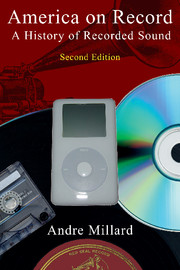Book contents
- Frontmatter
- Dedication
- Contents
- Preface to the second edition
- Preface to the first edition
- Introduction
- Part One The acoustic era
- Part Two The electrical era
- 6 The machines
- 7 Competing technologies
- 8 Empires of sound
- 9 Swing and the mass audience
- 10 High fidelity at last
- 11 Rock'n'roll and the revolution in music
- 12 The record
- 13 The studio
- 14 Perfecting studio recording
- 15 The cassette culture
- Part Three The digital era
- Abbreviations used in the notes
- Notes
- Select discography
- Select bibliography
- Subject index
- Recordings index
- Motion picture index
6 - The machines
from Part Two - The electrical era
Published online by Cambridge University Press: 05 February 2015
- Frontmatter
- Dedication
- Contents
- Preface to the second edition
- Preface to the first edition
- Introduction
- Part One The acoustic era
- Part Two The electrical era
- 6 The machines
- 7 Competing technologies
- 8 Empires of sound
- 9 Swing and the mass audience
- 10 High fidelity at last
- 11 Rock'n'roll and the revolution in music
- 12 The record
- 13 The studio
- 14 Perfecting studio recording
- 15 The cassette culture
- Part Three The digital era
- Abbreviations used in the notes
- Notes
- Select discography
- Select bibliography
- Subject index
- Recordings index
- Motion picture index
Summary
The history of technology is a relatively new area of study. Although writers such as Lewis Mumford and Aldous Huxley were examining the impact of technology on civilization in the 1930s, it was not until 1957 that a professional group was formed. As their prime source of evidence, historians of technology have machines – beautifully complex artifacts with the ideas of the times embedded in them. Historians of recorded sound have rich sources and do not have to travel too far to investigate them. Millions of players and records have survived. They can be found in museums and private collections all over the world, and often in the homes of elderly relatives.
What evidence can we uncover from an examination of these relics of the industry of recorded sound? The search for artifacts must begin at the Edison National Historic Site, an Aladdin's cave of old phonographs. Edison's old laboratory in West Orange, New Jersey, has been turned into a museum, and the machine shops, chemistry lab, and other experimental rooms are still there, looking much as they did when the great inventor was alive. There are phonographs in every part of the laboratory complex: amusement models, dictating machines, tiny players fitted into dolls, and concert phonographs which played huge cylinders.
On the third floor of the main laboratory building, there is one room of some significance to the historian of recorded sound. The only evidence that this was the first recording studio are the numerous recording horns strewn around the floor, long polished metal horns, enamelled horns with wide mouths, and horns that look like hats worn by witches. Each of these horns had a specific use in recording: the bell-shaped 14-inch brass horn was used for individual singers; the 26-inch japanned tin horn was best for banjo, violin, cornet, and band records; and the 6-foot-long horns were used for orchestras.
When the visitor enters the museum, an imposing machine called the kinetophone catches the eye immediately.
- Type
- Chapter
- Information
- America on RecordA History of Recorded Sound, pp. 115 - 135Publisher: Cambridge University PressPrint publication year: 2005



